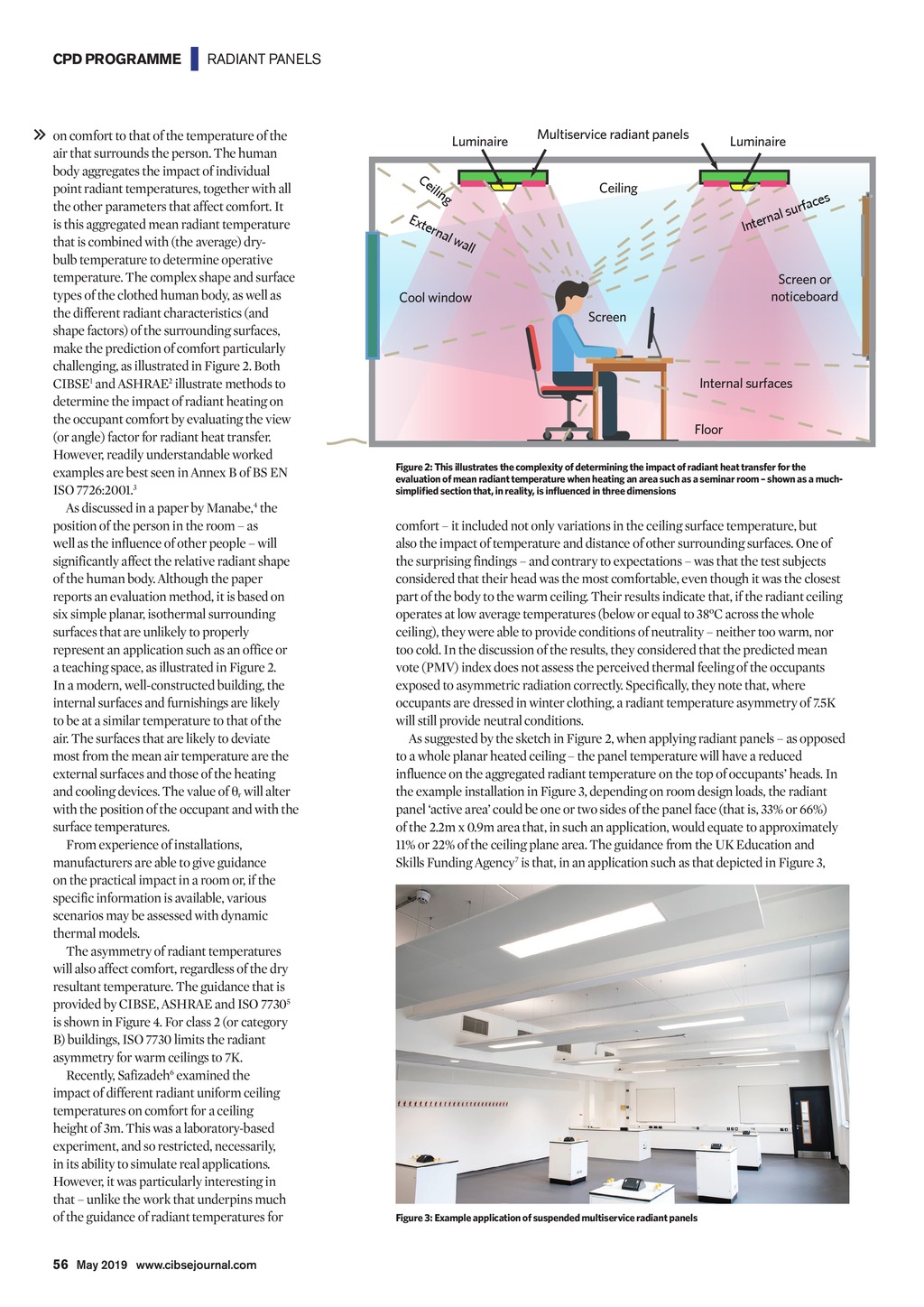




CPD PROGRAMME | RADIANT PANELS on comfort to that of the temperature of the air that surrounds the person. The human body aggregates the impact of individual point radiant temperatures, together with all the other parameters that affect comfort. It is this aggregated mean radiant temperature that is combined with (the average) drybulb temperature to determine operative temperature. The complex shape and surface types of the clothed human body, as well as the different radiant characteristics (and shape factors) of the surrounding surfaces, make the prediction of comfort particularly challenging, as illustrated in Figure 2. Both CIBSE1 and ASHRAE2 illustrate methods to determine the impact of radiant heating on the occupant comfort by evaluating the view (or angle) factor for radiant heat transfer. However, readily understandable worked examples are best seen in Annex B of BS EN ISO 7726:2001.3 As discussed in a paper by Manabe,4 the position of the person in the room as well as the influence of other people will significantly affect the relative radiant shape of the human body. Although the paper reports an evaluation method, it is based on six simple planar, isothermal surrounding surfaces that are unlikely to properly represent an application such as an office or a teaching space, as illustrated in Figure 2. In a modern, well-constructed building, the internal surfaces and furnishings are likely to be at a similar temperature to that of the air. The surfaces that are likely to deviate most from the mean air temperature are the external surfaces and those of the heating and cooling devices. The value of r will alter with the position of the occupant and with the surface temperatures. From experience of installations, manufacturers are able to give guidance on the practical impact in a room or, if the specific information is available, various scenarios may be assessed with dynamic thermal models. The asymmetry of radiant temperatures will also affect comfort, regardless of the dry resultant temperature. The guidance that is provided by CIBSE, ASHRAE and ISO 77305 is shown in Figure 4. For class 2 (or category B) buildings, ISO 7730 limits the radiant asymmetry for warm ceilings to 7K. Recently, Safizadeh6 examined the impact of different radiant uniform ceiling temperatures on comfort for a ceiling height of 3m. This was a laboratory-based experiment, and so restricted, necessarily, in its ability to simulate real applications. However, it was particularly interesting in that unlike the work that underpins much of the guidance of radiant temperatures for Luminaire Ce ilin g Multiservice radiant panels Luminaire Ceiling aces surf l a n r Inte Ext ern al w all Screen or noticeboard Cool window Screen Internal surfaces Floor Figure 2: This illustrates the complexity of determining the impact of radiant heat transfer for the evaluation of mean radiant temperature when heating an area such as a seminar room shown as a muchsimplied section that, in reality, is inuenced in three dimensions comfort it included not only variations in the ceiling surface temperature, but also the impact of temperature and distance of other surrounding surfaces. One of the surprising findings and contrary to expectations was that the test subjects considered that their head was the most comfortable, even though it was the closest part of the body to the warm ceiling. Their results indicate that, if the radiant ceiling operates at low average temperatures (below or equal to 38C across the whole ceiling), they were able to provide conditions of neutrality neither too warm, nor too cold. In the discussion of the results, they considered that the predicted mean vote (PMV) index does not assess the perceived thermal feeling of the occupants exposed to asymmetric radiation correctly. Specifically, they note that, where occupants are dressed in winter clothing, a radiant temperature asymmetry of 7.5K will still provide neutral conditions. As suggested by the sketch in Figure 2, when applying radiant panels as opposed to a whole planar heated ceiling the panel temperature will have a reduced influence on the aggregated radiant temperature on the top of occupants heads. In the example installation in Figure 3, depending on room design loads, the radiant panel active area could be one or two sides of the panel face (that is, 33% or 66%) of the 2.2m x 0.9m area that, in such an application, would equate to approximately 11% or 22% of the ceiling plane area. The guidance from the UK Education and Skills Funding Agency7 is that, in an application such as that depicted in Figure 3, Figure 3: Example application of suspended multiservice radiant panels 56 May 2019 www.cibsejournal.com CIBSE May19 pp55-58 CPD v2.indd 56 26/04/2019 17:14